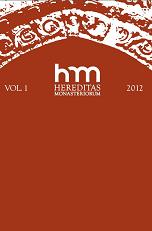Średniowieczne dziedzictwo sztuki ogrodowej klasztorów europejskich
Medieval heritage of the European monasteries garden arts
Author(s): Małgorzata MileckaSubject(s): History
Published by: Laboratoire de Recherches sur l'Histoire des Congregations et Ordres Religieux (LARHCOR)
Keywords: horticulture; Middle ages; Europe; monastery; monastic garden; symbolism of plants; botany; medicine; herbalism; magical practice; exorcism; archaeophyte; cultivated plants; the use of plants; heritage
Summary/Abstract: The tradition of the hermit orders emerged within the first two hundred years of Christianity, but it was st. Benedict who initiated the idea of the convent life based on the self-sufficiency and common living, improved during the 6th century. St. Benedict referred in a particular way to the words of Christ: „I was a stranger and you invited me in [...], I was sick and you looked after me” (Matthew 25:35–36). By putting the emphasis on warm hospitality for all of the travelers from different states and respect for the ill people, his philosophy shaped few types of monastic gardens. Among the other gardens there were: herbal (medical), kailyard and the orchard/graveyard. The input of the convents in the development of the horticulture is huge if consider the progress and dissemination of plant production, but also land cultivation, its fertilization, restoration and irrigation. The orders were leaders in techniques of management and usage of waters, forests, keeping the vineyards, orchards, and utilitarian and recreational gardens. The widespread of botanical and medical knowledge by collecting, copying and illustrating manuscripts is also owed to the convents. Many abbots had solid knowledge of gardening, but also of medicine according to st. Benedict. In particular, the Benedictines and Cistersians influenced the development of farming and gardening by expanding the boundaries of inhabited areas. A lot of convents were taking care of ill people, giving the beginning of hospital institutions. The monks’ records contain many useful information concerning the botanical knowledge and medical use of plants. This knowledge, however, has no Christian roots as it was transferred to the European grounds along with the inflow of the ancient Latin treaties to the Christian culture. What have left as a legacy of antiquity, and what was an important starting point for further development of the horticulure as a science, are four complete works on agriculture and one encyclopedic work containing botanical books on agriculture, gardening, and materia medica. A significant progress of the horticulture as an applied science have brought the times of Charles The Great, and several prominent brothers. It is worth to mention here the names of: Alcuin – the abbot of st. Martin monastery, the famous Benedict of Aniane – the abbot of Languedoc (considered as the author of the Capitulare de villis plant list), Gozbert of St. Gall, abbot Haito of Reichenau, but also the only women among the above mentioned – Hildegard of Bingen. Through their letters, plans, and even poems (Hortulus – the poem of Walafrid Strabo), it is now known a lot more about medieval monastic gardens, their composition, spatial structure, the species of cultivated plants, and their importance for contemporary people. The useful plants were highly valued at that time, not only as the healthy groceries, but also for their importance for medieval spirituality as the spiritual and symbolic value [...]
Journal: Hereditas Monasteriorum
- Issue Year: 2012
- Issue No: 1
- Page Range: 31-56
- Page Count: 26
- Language: Polish

